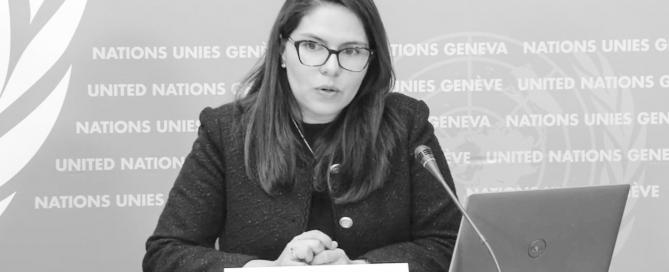Last 5th of April, at the United Nations Palais in Geneva, the World Health Organisation held a Press Conference on the rise of the arboviruses: dengue, zika, chikungunya and their relationship with Climate Change, and what WHO recommends to manage them.
Dr. Raman Velayudhan, the Director of the Global Program on the Control of Neglected Tropical Diseases and coordinator of the dengue and arbovirus Initiative, commenced his discourse on the gravity of dengue fever, which is the most frequently occurring viral infection transmitted by mosquitoes. He stated that “we are really at the right time to scale up the advocacy for the threat of arboviruses globally.”
For most people who get dengue for the first time, it may be considered a mild disease with a simple fever and body aches, Velayudhan says. However, getting dengue for the second time with another serotype can lead to severe cases of dengue, which could cause organ failure and death: “This is a big threat to the world since most countries now have all four serotypes in circulation.”
Unfortunately, dengue doesn’t have a treatment, and even vaccines are just emerging in the market. During his intervention, Dr. Velayudhan emphasized the exponential rise in dengue incidence in 2019, which reached around 5.2 million cases and made it the worst year for dengue during the COVID-19 pandemic. Moreover, as dengue affects many countries, the recording systems were struggling due to the pandemic.
As he recalled: “The only way to lower the risk of dengue is to avoid mosquito bites by Aedes aegypti, and Aedes albopictus.”
Therefore, as he stated, currently, around 129 countries are at risk of dengue, and it is endemic in over 100 countries. The geographic spread of dengue is expanding, and many countries in South America alone are recording dengue cases. Reports have also come from Sudan, Cambodia, Vietnam, Laos, the Philippines, Malaysia, and Singapore. This indicates that climate change has played a role in facilitating the spread of vector mosquitoes to the south: “When people travel, the virus goes with them.”
The highlighted factors affecting this increase include the movement of people, urbanization, and associated problems with water and sanitation, the continuous spread of vectors into new regions, increased precipitation, higher temperature, and higher humidity, all of which favour the mosquito. Even in a dry environment, the mosquitoes can breed.
Dr. Diana Rojas Alvarez, the technical lead for Zika and chikungunya, highlighted that chikungunya is also transmitted by Aedes mosquitoes and often co-circulates with other viruses in the same regions. The most common chikungunya symptoms’ include high fever, severe joint pain, stiffness, and rash, she mentioned. These symptoms typically last up to seven days, but up to 40% of those infected may continue to experience them for up to six months or even years after the initial infection. This can lead to lifelong disabilities and affect their quality of life. Alvarez stressed that infants and people aged 60 and above are at a higher risk of severe disease.
This year, as she stated, there was a record number of almost 35,000 chikungunya cases in just one week and the Americas declared an alert or an emergency due to the chikungunya virus.
Currently, three chikungunya vaccines are undergoing phase three trials, and they will soon apply for regulatory approvals in different countries. However, while waiting for a vaccine, Alvarez, advocated for the need to take personal protection measures, such as wearing mosquito repellent and clothes that cover their arms and legs during the day, especially for newborns and hospitalized patients, and eliminating mosquito breeding sites around homes: “Communities can also eliminate mosquito breeding sites around their homes and use bed nets during the day”, she said.
With travel resuming globally, the risk of introducing and spreading chikungunya in new areas is also increasing, especially where Aedes mosquitoes are present.
Therefore, WHO launched the Global Arbovirus Initiative in March 2022, which aims to monitor, anticipate, prevent epidemics and develop innovative tools and new vector control methods. Dr. Alvarez urges countries and the public to be prepared to detect and prevent further arboviral disease transmissions, such as dengue, Zika, and chikungunya.
Furthermore, she emphasized the importance of strengthening the healthcare surveillance system to be able to early detect, diagnose and do the appropriate supportive treatment. “Most countries now are using the capacities that were built for COVID-19 diagnosis doing molecular diagnosis and PCR to be able to diagnose arboviral diseases, which is a great tool to have when you are trying to identify different viruses that look very similar clinically”, she said.
For the potential global spread to Europe, Alvarez raised concerns about the increased risk of mosquito-borne diseases, such as dengue and chikungunya, spreading globally to Europe due to climate change. The Aedes mosquito, in particular, poses a unique challenge as its dry eggs can remain dormant for several months, and it has a habit of biting several people in one go, which could result in outbreaks in schools or workplaces.
In conclusion, WHO emphasizes the importance of being aware of the potential spread of mosquito-borne diseases and taking necessary precautions to prevent outbreaks. With climate change and the distribution of mosquitoes increasing, it is crucial to stay informed and take steps to protect ourselves and our communities from these diseases.
Acces the whole Press Conference: https://www.unognewsroom.org/story/en/1746/who-press-conference-05-april-2023




